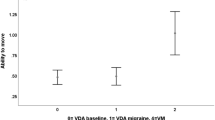Abstract
Background
Vestibular migraine (VM) is one of the most common causes of vertigo in clinical practice but it is not always easy to make the correct diagnosis. Our aims were to find out how VM patients differ from migraine only (MO) patients, to evaluate co-morbid depression in these two groups and to determine if their disease has an effect on their quality of life.
Methods
We studied 50 definite VM and 35 MO patients. Each patient was asked about: age of onset, duration of headaches, presence of aura, headache characteristics, triggering factors, associated features, motion sickness history and family history of migraine. VM patients were also asked about their vertigo attacks and accompanying symptoms. Each patient also completed the following questionnaires: (1) Migraine Disability Assessment Scale (MIDAS); (2) headache severity with VAS (Visual Analog Scale); (3) Allodynia Symptom Checklist (ASC-12); (4) Beck Depression Inventory (BDI); (5) World Health Organization Quality of Life Questionnaire Short Form-12 (WHOQL-SF12); (6) Activities Specific Balance Confidence Scale (ABC). VM patients also completed the Dizziness Handicap Inventory (DHI).
Results
We found that VM patients were more likely than MO patients to be female, post-menopausal, depressed, motion sick, complaining of imbalance and of food-triggered headaches. In contrast, MO patients were more likely than VM patients to have severe headaches and that these can be triggered by certain odors and by noise.
Conclusion
Our findings showed differences between VM and MO patients and attention to these differences could help clinicians diagnose, characterize and manage their VM patients.

Similar content being viewed by others
References
Boenheim F (1917) Uber familiare hemicrania vestibularis. Neurol Zentralbl 36:226–229
Lempert T, Neuhauser H (2009) Epidemiology of vertigo, migraine and vestibular migraine. J Neurol 256(3):333–338. https://doi.org/10.1007/s00415-009-0149-2
Headache Classification Committee of the International Headache Society (IHS) (2013) The international classification of headache disorders, 3rd edition (beta version). Cephalalgia 33(9):629–808. https://doi.org/10.1177/0333102413485658
Dieterich M, Obermann M, Celebisoy N (2016) Vestibular migraine: the most frequent entity of episodic vertigo. J Neurol 263(Suppl 1):S82–S89. https://doi.org/10.1007/s00415-015-7905-2
Welgampola MS, Young AS, Pogson JM et al (2019) Dizziness demystified. Pract Neurol 19(6):492–501. https://doi.org/10.1136/practneurol-2019-002199
Ertaş M, Siva A, Dalkara T et al (2004) Validity and reliability of the turkish migraine disability assessment (MIDAS) questionnaire headache. J Head Face Pain 44(8):786–793. https://doi.org/10.1111/j.1526-4610.2004.04146.x
Ekizoglu E, Baykan B, Orhan EK et al (2012) The analysis of allodynia in patients with idiopathic intracranial hypertension. Cephalalgia 32(14):1049–1058. https://doi.org/10.1177/0333102412457091
Beck AT, Ward CH, Mendelson M et al (1961) An inventory for measuring depression. Arch Gen Psychiatry 4:561–571. https://doi.org/10.1001/archpsyc.1961.01710120031004
Ware JE, Sherbourne CD (1992) The MOS 36 item short form health survey(SF-36) I: conceptional framework and item selection. Med Carem 30:473–480
Karapolat H, Eyigor S, Kirazli Y et al (2010) Reliability, validity, and sensitivity to change of turkish activities-specific balance confidence scale in patients with unilateral peripheral vestibular disease. Int J Rehabil Res 33(1):12–18. https://doi.org/10.1097/mrr.0b013e32832c0d72
Jeong SH, Oh SY, Kim HJ et al (2010) Vestibular dysfunction in migraine: effects of associated vertigo and motion sickness. J Neurol 257(6):905–912. https://doi.org/10.1007/s00415-009-5435-5
Balcı B, Akdal G (2020) Imbalance, motion sensitivity, anxiety and handicap in vestibular migraine and migraine only patients. Auris Nasus Larinks. https://doi.org/10.1016/j.anl.2020.02.015 (Advance online publication)
Murdin L, Chamberlain F, Cheema S et al (2015) Motion sickness in migraine and vestibular disorders. J Neurol Neurosurg Psychiatry 86(5):585–587. https://doi.org/10.1136/jnnp-2014-308331
Atkinson W, Sheldon TA, Shaath N, Whorwell PJ (2004) Food elimination based on IgG antibodies in irritable bowel syndrome: a randomised controlled trial. Gut 53:1459–1464. https://doi.org/10.1136/gut.2003.037697
Alpay K, Ertas M, Orhan EK, Ustay DK et al (2010) Diet restriction in migraine, based on IgG against foods: a clinical double-blind, randomised, cross-over trial. Cephalalgia 30(7):829–837. https://doi.org/10.1177/0333102410361404
Baldacci F, Lucchesi C, Ulivi M et al (2015) Clinical features associated with ictal osmophobia in migraine. Neurol Sci 36(1):43–46. https://doi.org/10.1007/s10072-014-1903-5
Murdin L, Premachandra P, Davies R (2010) Sensory dysmodulation in vestibular migraine: an otoacoustic emission suppression study. Laryngoscope 120(8):1632–1636. https://doi.org/10.1002/lary.21013
Takeuti AA, Fávero ML, Zaia EH et al (2019) Auditory brainstem function in women with vestibular migraine: a controlled study. BMC Neurol 19(1):144. https://doi.org/10.1186/s12883-019-1368-5
Kırkım G, Mutlu B, Olgun Y et al (2017) Comparison of audiological findings in patients with vestibular migraine and migraine. Turk Arch Otorhinolaryngol 55(4):158–161. https://doi.org/10.5152/tao.2017.2609
Park HJ, Viirre E (2010) Vestibular migraine may be an important cause of dizziness/vertigo in perimenopausal period. Med Hypotheses 75(5):409–414. https://doi.org/10.1016/j.mehy.2009.04.054
Akdal G, Özçelik P, Özge A (2020) Vestibular migraine: considered from both the vestibular and the migraine point of view. Neurol Sci Neurophysiol [serial online] 37:41–49. Available at: http://www.nsnjournal.org/text.asp?2020/37/2/41/288421.
Brandt T, Dieterich M (2020) “Excess anxiety” and “less anxiety”: both depend on vestibular function. Curr Opin Neurol 33(1):136–141. https://doi.org/10.1097/WCO.0000000000000771
Ten Voorde M, van der Zaag-Loonen HJ, van Leeuwen RB (2012) Dizziness impairs health related quality of life. Qual Life Res 21(6):961–966. https://doi.org/10.1007/s11136-011-0001-x
Kutay Ö, Akdal G, Keskinoğlu P et al (2017) Vestibular migraine patients are more anxious than migraine patients without vestibular symptoms. J Neurol 264(Suppl 1):37–41. https://doi.org/10.1007/s00415-017-8439-6
Acknowledgements
Authors thank Prof. Dr. G. M. Halmágyi for linguistic help and comments on the paper.
Funding
This study does not have any funding.
Author information
Authors and Affiliations
Corresponding author
Ethics declarations
Conflicts of interest
None of the authors have conflict of interest.
Consent to participate
All of the authors consent to participate.
Consent for publication
All of the authors consent for publication.
Ethics approval
Local ethics committee approved the study. All study procedures have been performed in accordance with the ethical standards laid down in the 1964 Declaration of Helsinki and its later amendments.
Rights and permissions
About this article
Cite this article
Özçelik, P., Koçoğlu, K., Öztürk, V. et al. Characteristic differences between vestibular migraine and migraine only patients. J Neurol 269, 336–341 (2022). https://doi.org/10.1007/s00415-021-10636-0
Received:
Revised:
Accepted:
Published:
Issue Date:
DOI: https://doi.org/10.1007/s00415-021-10636-0



